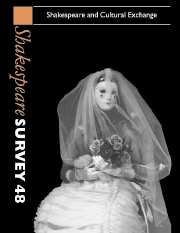Book contents
- Frontmatter
- Shakespeare Translation as Cultural Exchange
- Shakespeare, Theatre Production, and Cultural Politics
- ‘Amphitheaters in the Body’: Playing with Hands on the Shakespearian Stage
- ‘Shakespur and the Jewbill’
- Wilhelm S and Shylock
- Pilgrims of Grace: Henry IV Historicized
- Holy war in Henry V
- Hamlet and the Anxiety of Modern Japan
- Hamlet’s Last Words
- Venetian Culture and the Politics of Othello
- ‘My Music for Nothing’: Musical Negotiations in The Tempest
- The Tempest and Cultural Exchange
- Caliban and Ariel Write Back
- Shakespearian Rates of Exchange in Czechoslovakia 1945–1989
- ‘Are you a Party in this Business?’ Consolidation and Subversion in East German Shakespeare Productions
- The Martyred Knights of Georgian Shakespeariana
- Shakespeare Performances in England, 1993–1994
- Professional Shakespeare Productions in the British Isles, January – December 1993
- 1 Critical Studies
- 2 Shakespeare’s Life, Times, and Stage
- 3 Editions and Textual Studies
- Books Received
- Index
Caliban and Ariel Write Back
Published online by Cambridge University Press: 28 March 2007
- Frontmatter
- Shakespeare Translation as Cultural Exchange
- Shakespeare, Theatre Production, and Cultural Politics
- ‘Amphitheaters in the Body’: Playing with Hands on the Shakespearian Stage
- ‘Shakespur and the Jewbill’
- Wilhelm S and Shylock
- Pilgrims of Grace: Henry IV Historicized
- Holy war in Henry V
- Hamlet and the Anxiety of Modern Japan
- Hamlet’s Last Words
- Venetian Culture and the Politics of Othello
- ‘My Music for Nothing’: Musical Negotiations in The Tempest
- The Tempest and Cultural Exchange
- Caliban and Ariel Write Back
- Shakespearian Rates of Exchange in Czechoslovakia 1945–1989
- ‘Are you a Party in this Business?’ Consolidation and Subversion in East German Shakespeare Productions
- The Martyred Knights of Georgian Shakespeariana
- Shakespeare Performances in England, 1993–1994
- Professional Shakespeare Productions in the British Isles, January – December 1993
- 1 Critical Studies
- 2 Shakespeare’s Life, Times, and Stage
- 3 Editions and Textual Studies
- Books Received
- Index
Summary
It is no coincidence that the now hugely influential reading of The Tempest in the context of ‘the discourse of colonialism’ began for the purposes of the Anglo-American academy with Stephen Greenblatt’s essay ‘Learning to Curse’, published in 1976, in a book called First Images of America: The Impact of the New World on the Old which explicitly marked – in troubled fashion – the bicentenary of the American Declaration of Independence. As was the case more recently in Australia, official celebrations of a young nation’s coming to the age of two hundred released an anguished cry from the liberal intelligentsia as they came to full realization of the exploitation and oppression on which their nation was built. Fashionable criticism is interested in assuaging the guilt of empire by making the author of The Tempest a scapegoat. But I find it mildly ironic that very few of the ‘radical’ critics of the 1970s and 1980s have acknowledged that a revisionary reading of The Tempest had already been undertaken in the 1950s and 1960s by non-white non-Europeans. I have to admit to my shame that I have been much longer familiar with the ‘new historicist’ readings of anguished Stefanos like Stephen Greenblatt, Stephen Orgel and Steven Mullaney than with the remarkable creative work done a generation before them by self-proclaimed Calibans like George Lamming, Edward Kamau Brathwaite, Aimé Césaire and Roberto Fernández Retamar.
- Type
- Chapter
- Information
- Shakespeare Survey , pp. 155 - 162Publisher: Cambridge University PressPrint publication year: 1996



